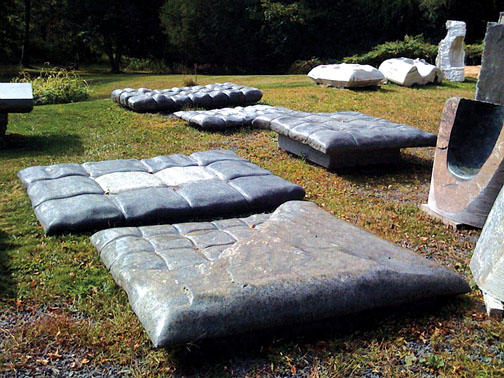Alumni Profile: Mark Mennin '82

HEAVY LIFTING
With a baseball cap on backward, a breathing mask, and ear protection, Mennin looks like a man who works for a living. No fancy ties, shiny shoes, or heated office. But he’s not a laborer, he’s an artist. His tools: a forklift to move 15,000-pound sections of stone, as well as saws, torches, chisels, compressors, and jackhammers that he uses to break off, grind, shape, and polish granite and marble.
FROM FIGURATIVE HEADS TO SUNDIALS
Mennin’s work has been exhibited in galleries in New York and abroad and has been installed in both private and public spaces. Among his smaller works are glowering and grimacing heads made of limestone or marble. His latest large-scale granite installations are public commissions for universities — “Magma cum laude,” two fountains joined by a walkway and including sculptural seating for 32 arranged in a courtyard at Stanford Law School, was installed this month. At Penn State, he is making a giant sundial — a 14-foot granite spearlike structure stuck in the ground on an angle (called a gnomon) that will cast a shadow on 30 abstract carvings arranged in two semicircles and a straight line — to be installed in May. The sundial is a functional work of art: To ensure that it will mark the hours of the day accurately, Mennin consulted with Penn State astrophysicists.
CONTEMPORARY APPROACH TO AN ANCIENT TRADITION
The payoff for public commissions like those at Stanford and Penn State, Mennin says, is that “thousands of people are rolling on them and sitting on them and touching them.” He makes bedlike sculptures that are “about bonding a real body to an earth material. It becomes a tidier way of rolling around in the mud” and a way to feel how soft our bodies are next to something that “can feel deceptively soft and look deceptively soft,” but is dense and hard. Stone provides the “challenge of making something fresh and contemporary and relevant out of something that has more history than any other material.”












No responses yet